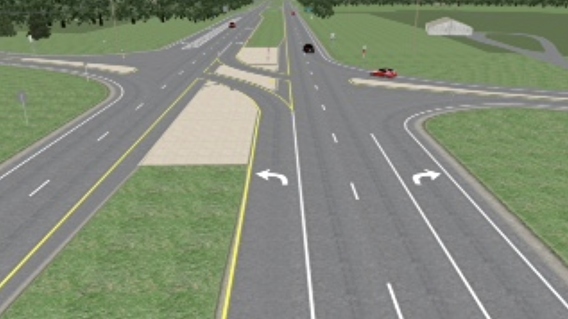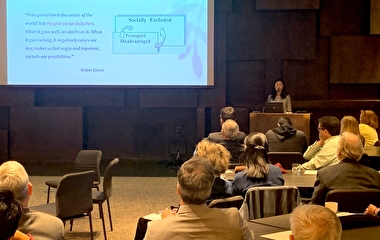
Many of us have been there before: You’re on a side road approaching a stop sign at a four-lane divided highway and want to turn left. You wait for a safe gap in traffic, hoping you estimate the speed and distance of oncoming cars and time your move correctly to avoid a crash.
Rural intersections in Minnesota consistently experience high rates of fatal and serious injury crashes due to this exact scenario. To help mitigate this risk, MnDOT has been installing restricted crossing U-turn (RCUT) intersections across the state.
RCUTs require drivers on the side road to make a right turn and then—at a break in the median some distance later—make a U-turn to complete a left turn (or make an additional right turn to continue straight on the side road). This removes the need for vehicles to cross traffic and reduces the number of possible danger points. MnDOT has installed 60 RCUTs since 2009.
Though they might seem counterintuitive at first, RCUTs significantly improve safety. In 2021, MnDOT conducted before-and-after analysis of these intersections and found that those converted to RCUTs have seen a 69 percent reduction in fatal and serious-injury crashes. However, their implementation is sometimes met with resistance from community members.
Scott Thompson, traffic engineer for MnDOT’s District 7 in southwestern Minnesota, says RCUTs can be constructed for a fraction of the cost of an interchange. But when first introduced to the public, they can result in confusion and frustration—and then ultimately online petitions and social media campaigns against the improvement, he says.
Enter U of M HumanFIRST Laboratory Director Nichole Morris and her team. Their goal was to develop methods for engaging community members around RCUTs to increase public acceptance.
“We wanted to answer these questions: How are drivers understanding RCUTs, and can we improve performance from novice users at these intersections?” Morris says. “How are we increasing buy-in, so we have more ease in deploying these RCUTs in places where they’re needed?”

The first phase of the study was an RCUT driving performance test using an immersive simulator in the HumanFIRST Lab. The researchers recruited 36 participants from across Minnesota who were unfamiliar with RCUTs to help the team understand novice driver performance at these intersections as well as the role of signage levels on performance.
Participants in the simulator navigated left-hand turns in two traditional intersections and three RCUT intersections, with varying degrees of signage. Common driving errors in the simulator included 1) failure to make the U-turn, 2) late turns into the deceleration lane, and 3) failure to turn into the correct lane on the highway.
In general, researchers found that driving performance improved with repeated RCUT exposure. The level of signage had little effect on driving performance—however, results suggested a moderate level of signage is best.
“Practice seemed to make ‘more perfect,’ but we don’t want drivers to have bad experiences with their first RCUT exposure because of the risk of very critical errors,” Morris says. “We didn’t pair this simulation with any educational materials, so we would want to do that in the real world.”
Researchers also measured the participants’ attitudes toward RCUTs both before and after using the simulator, asking them whether they thought these intersections would be a good idea in their own communities. Overall, they found this simulated driving experience was not powerful enough to improve participants’ attitudes toward RCUTs.
In the second phase of the study, Morris and her team evaluated persuasive messaging techniques. They analyzed how testimonials affected attitudes toward RCUTs, using a large sample study of participants from across Minnesota to determine which techniques resonated in different areas.
More than 160 participants watched testimonial videos produced by MnDOT, which highlighted speakers telling personal anecdotes, sharing information, or giving opinions. Those living outside the seven-county metro were most persuaded by testimonials showing how RCUTs could affect their own lives. Those living inside the metro area were more swayed by testimonials that immersed them in the story and contained a credible and trustworthy speaker. Uniformly, people left this testimonial study feeling more positive and open to RCUTs.
For the large sample study, more than 400 people were randomly assigned to four different techniques: testimonials, informational videos, PowerPoint presentations, and a virtual reality video.
Once again, what resonated most with people depended on where they lived. Rural residents were most influenced by hearing testimonials or experiencing the RCUT via virtual reality. Suburban residents were most influenced by testimonials. Urban residents were most influenced by informational videos or PowerPoint presentations. No matter the technique, most people left the study feeling more supportive of RCUTs.
So, what are some of the final recommendations that came out of this research?
- Use a mixed-messaging strategy when communicating about upcoming roadway changes, since what resonates most with people varies.
- When making decisions about reducing presentation content, don’t remove testimonials to meet time constraints since they tend to be quite effective.
- For less invested people, use shorter and persuasive messages.
- Lead persuasive messaging with information about the benefits of RCUTs so people's minds are more at ease while they learn about RCUTs.
Two other findings also caught Morris’s attention. “Support for roundabouts predicts support for RCUTs,” she says. “And interestingly, people are more willing to drive on RCUTs than have them in their communities.”
This research was sponsored by MnDOT. Morris and Thompson, along with Victor Lund (traffic engineer, St. Louis County) and Derek Leuer (state traffic safety engineer, MnDOT) discussed the project at a CTS webinar last fall.
Writer: Maggie Biever


